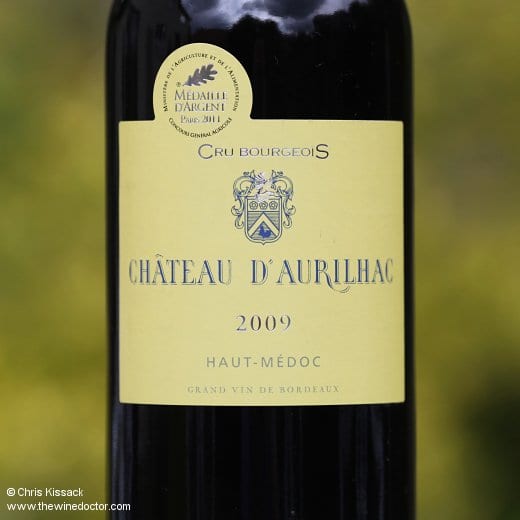Château d’Aurilhac 2009
The last few weeks have seen a torrent of wines from the Loire Valley feature in my Monday Weekend Wine update, a reflection purely of how many wines from this region I drink, bolstered by a long visit to the region during the summer. Without trying I seem to have touched on all four of the Loire’s major regions, from Domaine Masson-Blondelet in Pouilly-Fumé down to Pierre- Luneau-Papin in Muscadet country. Now it feels like it is time to look somewhere else. With the annual Bordeaux Cru Bourgeois tasting coming up later this week, and two trips to Bordeaux lined up for October, my choice of wine today is an easy one.
The 2009 Bordeaux vintage continues to prove a happy hunting-ground for buyers looking for affordable, drinkable Bordeaux, a fact reaffirmed by this week’s wine, the 2009 from Château d’Aurilhac in the Haut-Médoc appellation. On the left bank it is this appellation that is perhaps likely to yield the most interesting results in a search for a wine that combines Bordeaux character in the glass with a less Bordeaux-like attribute in the price tag. I tend to divide this very extensive appellation into sections, in order to better understand the potential and style of the wines, and Château d’Aurilhac is to be found in the very northern part, among the gently rolling vineyards that run from the Estey d’Un, the drainage channel at the top of St Estèphe, up to the Chenal de la Maréchale, the waterway that marks the beginning of the Médoc.

This is St-Seurin-de-Cadourne, a commune with a distinct advantage over many other sections of the Haut-Médoc appellation, in that it looks down onto the Gironde. Further south, the Haut-Médoc vineyards are pushed back from the water by the more prestigious appellations of St Estèphe, Pauillac, St Julien and Margaux. This gives the vineyards of the northern section, of which the best known is without doubt Château Sociando-Mallet, a distinct advantage. First, there are several great croupes of gravel here, similar to those found further south on which sit Château Montrose, Château Cos d’Estournel and the like. Secondly, there seems to be a ripening advantage, which I assume (or I am told) is related to the proximity of the Gironde which has a large, moderating effect on the local temperatures. Certainly, during the primeurs, whenever I visit Château Sociando-Mallet I am always impressed by how advanced the vines are compared to those spotted further south, even those south of Bordeaux (when logic would seem to suggest it should be the other way around). How far inland does this ripening advantage stretch, I wonder?
Château d’Aurilhac is located almost directly west of Château Sociando-Mallet, on the Route de Lesparre which heads inland towards the Médoc domaines of Château Potensac and Château Preuillac. As such it is about four or five kilometres inland from the Gironde. Proprietor Erik Nieuvall carried out extensive replanting in 1983, with quite a significant percentage of Merlot (44%) along with 50% Cabernet Sauvignon and 3% each Cabernet Franc and Petit Verdot. In the glass the 2009 has a very dark appearance, showing a red-black hue at its core, with a deeply coloured, thin, smoky-red rim. The nose is very youthful, with smoky and somewhat caramelised oak battling it out against a wealth of sweet fruit, led by the dark scents of blackcurrants and cherry, but there is also a fresh and lifted tinge of strawberry to it that is certainly quite noticeable, along with a rather subtle, leafy, blackcurrant-skin character. It doesn’t have more autumnal and earthy edge I know some would look for in the Haut-Médoc, but instead it presents a rather appealing melange of savoury Cabernet fruit set against the sweetness of Merlot, in a frame of oak that yet needs to integrate. The palate confirms this, showing a very firm straitjacket of youthful grip and polished oak at present, with a rather lush fruit texture, nice acidity though, and a lot of substance overall. This is a good wine, showing the worth of a vintage such as 2009, although the grippy tannin, as well as the youthful fruit and oak, don’t suggest this is an easy-drinking wine to pop and pour. This is one for the cellar in my opinion. 16/20 (22/9/14)
